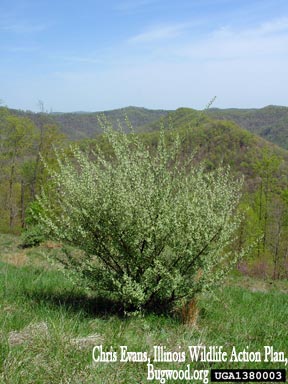Autumn Olive
(Elaeagnus umbellata)
Family: Oleaster Family (Elaeagnaceae)
Native Range: East Asia
 Autumn olive is a deciduous shrub that can grow to 20 ft. in height. The stems, buds and leaves have a dense covering of silvery to rusty scales. Leaves are alternate, egg or lance-shaped, smooth margined, dull green above and often with brown scales beneath.
Autumn olive is a deciduous shrub that can grow to 20 ft. in height. The stems, buds and leaves have a dense covering of silvery to rusty scales. Leaves are alternate, egg or lance-shaped, smooth margined, dull green above and often with brown scales beneath.
Autumn olive flowers in June and July. The densely clustered blossoms are aromatic, pale yellow, and fused at the base with 4 petals pointed at the tips. Small, red-brown to pink fruit is produced in August through October. The fruit is dotted with brown or silvery scales.
Look-alikes
- Russian olive (Elaeagnus angustifolia) leaves are narrow-elongate with silvery scales on both sides and fruit is mealy, yellow or silvery;
- Thorny olive (E. pungens) has leaves that are persistent, egg-shaped with wavy margins, upper surfaces shiny green, lacking scales, and lower surfaces covered with dull white scales and dotted with light brown scales.
Ecological Threat
Autumn olive threatens native ecosystems by out-competing and displacing native plant species, creating dense shade and interfering with natural plant succession and nutrient cycling.
Distribution and Background
Autumn olive was introduced into the United States in 1830 and widely planted as an ornamental, for wildlife habitat, as windbreaks and to restore deforested and degraded lands.
Alternative Plants (Alternative native Species)
Many attractive native shrubs are available that make great substitutes for autumn olive. A few examples include:
- Downy serviceberry (Amelanchier arborea)
- Black chokeberry (Aronia melanocarpa)
- Gray dogwood (Cornus racemosa)
- Redosier dogwood (Cornus sericea)
- Winterberry(Ilex verticillata)
- Arrowwood viburnum (Viburnum dentatum)
Whenever possible, use as alternatives plant species that are native and adapted to the ecological region where you live. They will be more valuable to the wildlife species that have evolved with them and depend upon them for food and shelter. Check with your local native plant society for recommendations and sources of native plants.
Biology and Spread
 Autumn olive is found from Maine to Virginia and west to Wisconsin in grasslands, fields, open woodlands and other disturbed areas. It is drought tolerant and thrives in a variety of soil and moisture conditions. Because autumn olive is capable of fixing nitrogen in its roots, it can grow on bare mineral substrates.
Autumn olive is found from Maine to Virginia and west to Wisconsin in grasslands, fields, open woodlands and other disturbed areas. It is drought tolerant and thrives in a variety of soil and moisture conditions. Because autumn olive is capable of fixing nitrogen in its roots, it can grow on bare mineral substrates.
Autumn olive seed is dispersed by birds and mammals; some vegetative propagation also occurs.
Management Options
Mechanical and chemical methods are the primary means of control for autumn olive.
For disposal options, refer to the control and disposal page.
Plant Control
Manual, mechanical and chemical means are available to control established plantings.
Biological
At this time no means of biological control is available for controlling autumn olive.
Manual
Remove young seedlings by hand before they produce seeds. Seedlings are best pulled after a rain when the soil is loose. Remove the entire root system to avoid resprouting.
Mechanical
Cutting or mowing is effective in controlling autumn olive. Cutting is most effective when combined with an application of herbicide to cut surfaces. A digging fork or weed wrench may be used to uproot small to medium sized shrubs. Try to remove the entire root system if possible.
Stems should be cut at least once during the growing season, and as close to ground level as possible.
Chemical
Apply systemic herbicides like glyphosate and triclopyr to control autumn olive.
More Information
For more information on invasive species in Massachusetts, refer to the Massachusetts Prohibited Plant List at https://www.mass.gov/massachusetts-prohibited-plant-list
References
Pennsylvania Department of Conservation and Natural Resources, DCNR Invasive Exotic Plant Tutorial for Natural Lands Managers http://www.dcnr.state.pa.us/cs/groups/public/documents/document/dcnr_010230.pdf
Center for Invasive Species and Ecosystem Health http://www.invasive.org/browse/subinfo.cfm?sub=3021
Invasive plant Species Assessment Working Group http://www.in.gov/dnr/files/Autumn_Olive.pdf